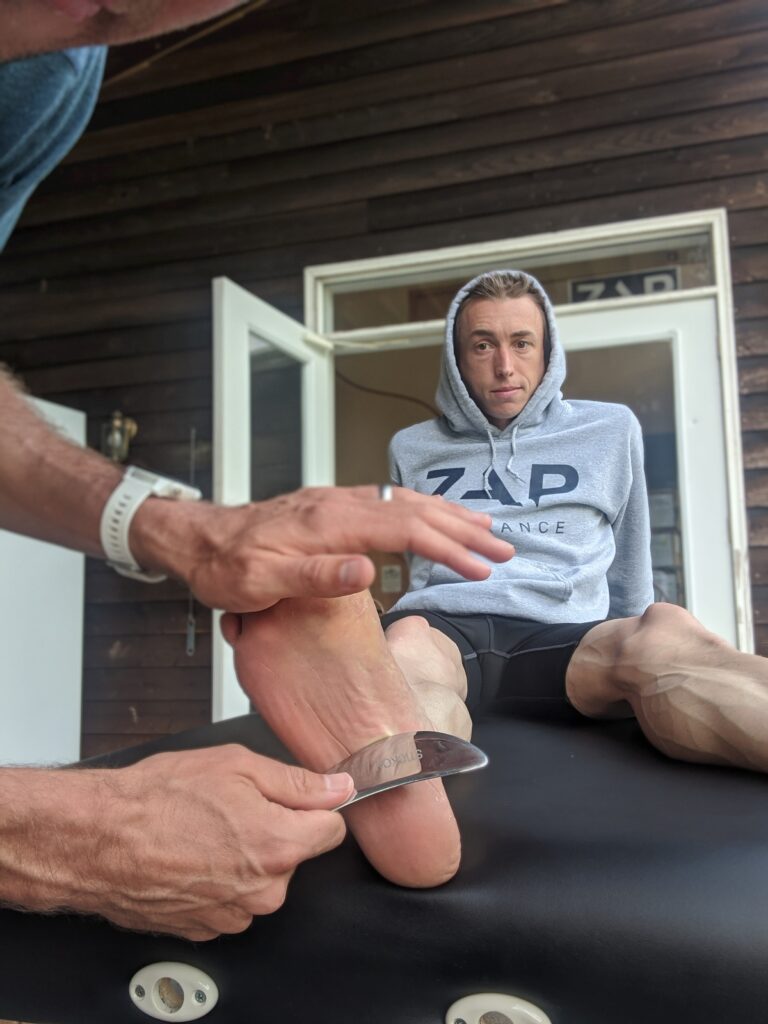
For more information on ZAP Personal Coaching click here.
Plantar fasciitis is one of the most vile, insidious issues runners encounter. It’s like the cockroach of running injuries, coming up out of nowhere and seemingly impossible to get rid of.
Despite that reputation, there are a number of treatment options you can pursue to alleviate the pain and discomfort caused by plantar fasciitis. It is important, and obvious, to note that the following recommendations are based on your injury actually being plantar fasciitis. Things like a ruptured or torn plantar fascia require a much different form of treatment. So if you have swelling or bruising at the site of the pain or are unsure of the source of pain you should absolutely see a podiatrist … Which feels like a perfect time to plug Dr. Brian Fullem’s Book, A Runner’s Guide to Healthy Feet and Ankles.
If you read this book (and you should!), you’ll notice many of my recommendations shamelessly ripped from those pages. Plus you’ll get way more knowledge about how to treat all kinds of lower leg issues (sweet!) Dr. Fullem has been treating our athletes here at ZAP successfully for years and what he says or writes comes with the full ZAP seal of approval.
Disclaimer out of the way, let’s move on to squashing this cockroach of an injury:
1. Plantar Fasciitis Self Massage
I’m just going to cut to the chase with this one. Spending time rolling your foot out on a golf ball is all well and good, but if you’re dealing with chronic plantar fasciitis you need to pull out the big guns: i.e. your thumb. For this masochistic exercise what you’re going to do is: using your thumb, dig into the plantar while using the other hand to pull back your toes, stretching the bottom of your foot underneath the pressure of your thumb. Pick up your thumb, place it slightly farther down the plantar fascia, and repeat. If this makes zero sense, check out the video below.
Plantar fasciitis along the entire stretch from your heel to your toes is relatively common. So focus your attention on where it’s bothering you most. You’ll likely feel a crunchy texture where you have the most discomfort. This is scar tissue that builds up in the fascia, further restricting the fascia’s movement, and it needs annihilated.
Now, as you may expect, one should not undertake the annihilation of scar tissue lightly. This can be an eyes watering experience. Even for the most pain addicted among us, it is difficult to perform this effectively on yourself. I would recommend finding someone who loves you very much, and/or someone who would find enjoyment in watching you squirm, butter them up with lots of nice compliments, then ask them to perform this technique on you.
You should be able to revisit this regularly, up to 4-5 times a week until the symptoms are gone and you’ve eliminated that diabolical rice krispy texture from the bottom of your foot.
2. Rolling
Rolling your foot out on a golf ball or firm therapy ball works great for general maintenance, and you can use that a few times a week once you’re pain free. However, in my experience it isn’t aggressive enough to fix a case of chronic plantar fasciitis.
Rolling your foot on a frozen water bottle in the evening can help alleviate the discomfort, but just remember: do this AFTER you’ve run. Heat before running, cold after running. Always. Unless it’s blazing hot and you’re dumping cold water on your head, then proceed.
3. Graston Technique

If you think a thumb is uncomfortable try having someone rake a metal tool across the bottom of your flexed foot. The idea here is the exact same as the self massage, but it’s a more aggressive treatment that is done by a Graston Technique Provider.
I have seen a lot of success with as well through the ZAP team and personal coaching clients both. Just know it will take multiple sessions to vanquish the enemy.
4. Strassburg Sock
In a cruel attempt to ruin your day before it even begins, your plantar fasciitis often causes the most pain when you first step out of bed in the morning. If it does, the deep, dark truth may be that your plantar fasciitis is playing marionette to the real masterminds, your achilles and calf (more on that in a minute.) Essentially what happens is your calves get tight, pull on your achilles’, which shares fibers with your plantar fascia, thus, pulling on your plantar and causing the pain in your foot.
When you sleep your calves and achilles’ shorten. This creates a shock to the system when you, unaware of the evil that has been orchestrated overnight, put all your body weight on your foot in a flexed position. You can stretch your foot by gently pulling your toes toward shins 10-20 times before you step out of bed to lessen the blow.
However, the best fix is to keep the foot in a flexed position with a Strassburg Sock or a immobilization boot overnight. I’d recommend the sock. While it’s not the most comfortable thing, you will get used to it, and it beats sleeping in a giant plastic boot. You might find this alone could fix your plantar fasciitis pain.
5. Proper Footwear
In the interest of time, I’ll keep this one short. Wear supportive footwear all day while you have plantar fasciitis symptoms. Have a pair of shoes near your bed you can slip on first thing in the morning. Avoid walking around barefoot as much as possible. Avoid wearing sandals or flats. Lastly, avoid wearing things like high heels that shorten the calf-achilles-plantar complex and can exacerbate the shortening-stabbing pain cycle.
6. Shockwave Therapy

We’ve had tremendous success with Shockwave Therapy for all sorts of fascia and tendon issues, including plantar fasciitis. You’ll need to see a podiatrist for this. The downside is most insurance carriers will make you pay out of pocket for treatments.
A Shockwave machine, as I understand it, essentially pummels your plantar fascia into submission with high frequency acoustic waves. It was originally used to break up kidney and gallstones, which feels like a fitting fate for plantar fasciitis.
7. Always Look Up the Chain
As I alluded to in the Strassburg Sock section, often times pain caused by an injury is merely a symptom of a larger issue. With plantar fasciitis this is typically tightness in the calves that pull on the achilles, which in turn pulls on the plantar fascia. So even though your calves may not hurt, get them massaged, foam roll them. Loosening up your calves could be the key to unlocking your plantar fasciitis pain. And this principle should be applied to all types of injuries – always look to the top or bottom of the chain and work down or up to try and find imbalance, weakness, or lack of mobility.
Final Thoughts
Plantar fasciitis can be chronic and it can feel hopeless. Rest assured you’re not alone in feeling that way. These are the best tools I’ve seen to go on the offensive and attack the vile beast from multiple angles. If you want more information on plantar fasciitis, or any other lower leg issue, I highly recommend Dr Fullem’s book. He’s the podiatrist who sees our ZAP Endurance athletes, and has been an incredible resource for us over the years.
Now it’s time to get to squashing to take your running back from the cockroach that is plantar fasciitis!
